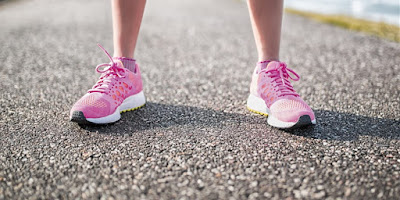Fold into Paschimottanasana to help a distracted mind—and your hamstrings—unwind.
(POSH-ee-moh-tan-AHS-anna)
paschimottana = intense stretch of the west (pashima = west
uttana = intense stretch)
Seated Forward Bend Yoga Pose: Step-by-Step Instructions
Step 1:
Sit on the floor with your buttocks supported on a folded blanket and your legs straight in front of you. Press actively through your heels. Rock slightly onto your left buttock, and pull your right sitting bone away from the heel with your right hand. Repeat on the other side. Turn the top thighs in slightly and press them down into the floor. Press through your palms or finger tips on the floor beside your hips and lift the top of the sternum toward the ceiling as the top thighs descend.
Step 2:
Draw the inner groins deep into the pelvis. Inhale, and keeping the front torso long, lean forward from the hip joints, not the waist. Lengthen the tailbone away from the back of your pelvis. If possible take the sides of the feet with your hands, thumbs on the soles, elbows fully extended; if this isn't possible, loop a strap around the foot soles, and hold the strap firmly. Be sure your elbows are straight, not bent.
Step 3:
When you are ready to go further, don't forcefully pull yourself into the forward bend, whether your hands are on the feet or holding the strap. Always lengthen the front torso into the pose, keeping your head raised. If you are holding the feet, bend the elbows out to the sides and lift them away from the floor; if holding the strap, lighten your grip and walk the hands forward, keeping the arms long. The lower belly should touch the thighs first, then the upper belly, then the ribs, and the head last.
Step 4:
With each inhalation, lift and lengthen the front torso just slightly; with each exhalation release a little more fully into the forward bend. In this way the torso oscillates and lengthens almost imperceptibly with the breath. Eventually you may be able to stretch the arms out beyond the feet on the floor.
Step 5:
Stay in the pose anywhere from 1 to 3 minutes. To come up, first lift the torso away from the thighs and straighten the elbows again if they are bent. Then inhale and lift the torso up by pulling the tailbone down and into the pelvis.
Seated Forward Bend Yoga Pose Information:
Sanskrit Name:
Paschimottanasana
Pose Level:
1
Contraindications and Cautions:
- Asthma
- Diarrhea
- Back injury: Only perform this pose under the supervision of an experienced teacher.
Modifications and Props:
Most students should sit up on a folded blanket in this pose, and most beginners need to hold a strap around the feet. Extremely stiff students can place a rolled up blanket under their knees.
Deepen the Pose:
Once you are fully in the forward bend you can re-extend the elbows. There are several ways to do this. You can clasp your hands around the soles of the feet, or turn the back of one hand to the soles and grip its wrist with the other hand. You can also place a block against the soles of your feet and grip its sides with your hands.
Preparatory Poses:
- Balasana
- Janu Sirsasana
- Uttanasana
Follow-up Poses:
Beginner's Tip:
Never force yourself into a forward bend, especially when sitting on the floor. Coming forward, as soon as you feel the space between your pubis and navel shortening, stop, lift up slightly, and lengthen again. Often, because of tightness in the backs of the legs, a beginner's forward bend doesn't go very far forward and might look more like sitting up straight.
Health Benefits:
- Calms the brain and helps relieve stress and mild depression
- Stretches the spine, shoulders, hamstrings
- Stimulates the liver, kidneys, ovaries, and uterus
- Improves digestion
- Helps relieve the symptoms of menopause and menstrual discomfort
- Soothes headache and anxiety and reduces fatigue
- Therapeutic for high blood pressure, infertility, insomnia, and sinusitis
- Traditional texts say that Paschimottanasana increases appetite, reduces obesity, and cures diseases.
Partnering:
A partner can help you release your lower back in this pose. Have your partner stand behind you facing your back. Perform the pose, then have your partner press his/her hands against your lower back and pelvis. The hands should be turned so the fingers point towards your tailbone. Remember though that the pressure isn't to push you deeper into the forward bend; rather, gentle pressure (parallel to the line of the back) encourages the back spine and tailbone to lengthen away from the torso. Extend the front torso against this downward action.
Variations:
Urdhva Mukha (urdhva = upward; mukha = face) Paschimottanasana
Lie on your back, exhale, and bend your knees into your torso. Then inhale and extend the heels toward the ceiling. Slowly, on an exhalation, swing your feet toward the floor above your head. You may or may not be able to reach all the way to the floor. Try not to let the back of the pelvis lift very far from the floor—this is an upside-down version of Paschimottanasana, not Salamba Sarvangasana or Halasana.
Content & Image Source: https://www.yogajournal.com/poses/seated-forward-bend
Content & Image Source: https://www.yogajournal.com/poses/seated-forward-bend












